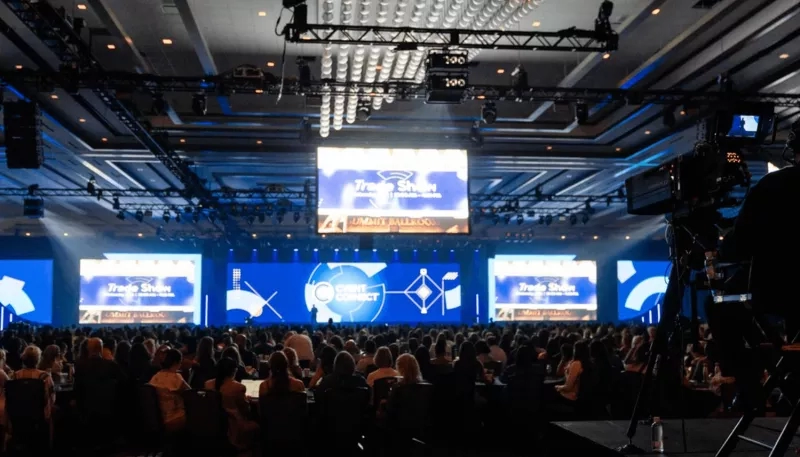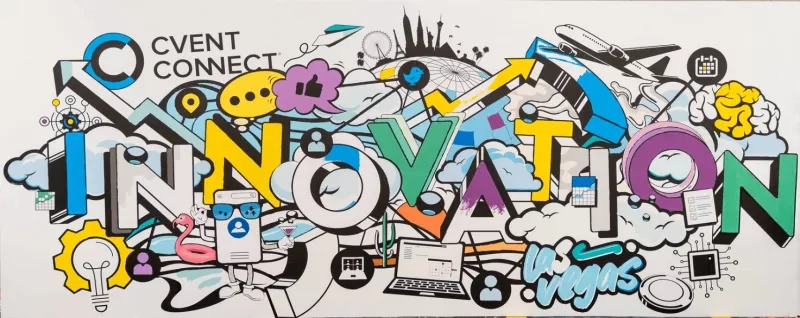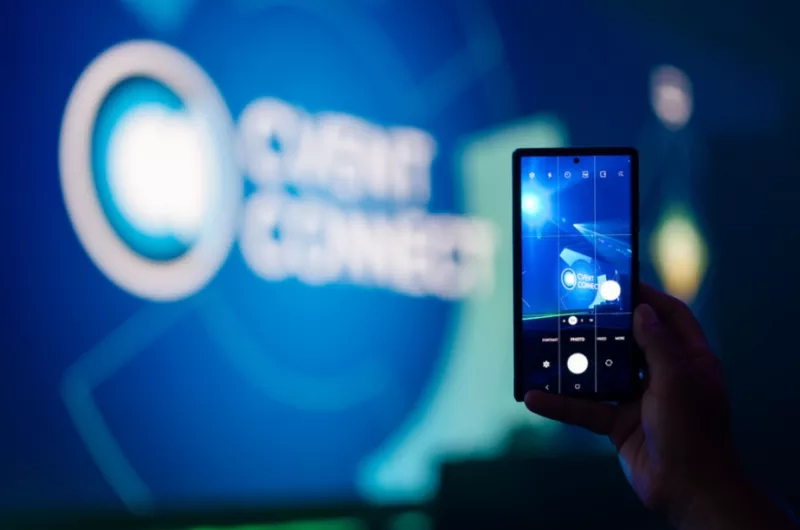Conferences and events are a significant part of marketing and engagement strategies for many organizations. Studies show that one-day conferences are the most common event, held by 54% of companies, followed by product training and business or channel partner events. Additionally, 31% of event marketers see trade shows and conferences as essential for business.
With so many events competing for attention, having a solid brand identity is more critical than ever. But what makes for effective conference branding? This guide will explore the impact of branding, strategies to build a memorable brand, and creative ways to bring your conference identity to life.
What is Conference Branding?
At its core, conference branding shapes how your event is perceived. It encompasses people's personalities, emotions, and associations when they encounter your conference name, logo, materials, and overall experience.
More than just visual branding, it involves positioning your event in the minds of potential sponsors and attendees. It's about figuring out what makes your conference unique and conveying that clearly through every touchpoint.
The Relationship Between Branding and Conference Identity
The brand is the personality of your event. It comprises visuals, messaging, experiences—anything that shapes how people perceive your conference. An impactful brand immediately conveys what makes your event unique. It acts as a "mental shortcut," allowing potential attendees and sponsors to understand what you stand for quickly.
Crafting a unique brand identity involves defining your conference's:
- Purpose: What do you aim to achieve with your event? Who is your target audience?
- Values: What principles guide your conference programming and planning?
- Personality: If your conference was a person, how would you describe their character? Are they serious, fun, and innovative?
- Tone: What kind of language and visual style fits your brand?
When all these elements align, your conference brand gains coherence. The logo design, website, signage, and everything people see and interact with work together to reflect the event's identity. This creates a memorable, differentiated experience that leaves a distinct impression.
Steps to Create a Successful Conference Brand
Developing a strong brand takes strategic planning across each phase of conference management. Here are some best practices for crafting conference branding:
Research
-
- Conduct pre-event surveys and phone interviews with past/potential attendees.
- Ask questions to identify challenges, goals, and preferences.
- Review data from competitor conferences over past years.
- Analyze industry reports and news to identify relevant trends.
- Define attendee demographics, psychographics, and firmographics.
Define Your Brand
-
- Distill research findings into a 1-sentence brand promise statement.
- Ensure promise highlights your competitive differentiation.
- Align promise with target audience priorities and preferences.
- Determine ideal brand personality descriptors (e.g., innovative, authoritative, fun).
- Set specific brand awareness and positioning goals.
Create Visual Identity
-
- Design a memorable, unique logo aligned with the brand promise.
- Choose 2-3 brand colors that evoke desired emotions from attendees.
- Select 1-2 fonts that communicate brand personality.
- Create custom graphic elements and illustrations reflecting the brand.
- Develop visual brand guidelines, including typography, color codes, and logo usage.
Integrate Branding
-
- Prominently display logo and brand colors on the website header.
- Incorporate brand fonts, shapes, and illustrations into page design.
- Use logo, colors, and fonts cohesively across all event signage.
- Include brand elements prominently but cleanly in conference branding materials like brochures, ads, and emails.
- Add logo to presentation templates, conference app, and name badges.
- Brand promotional materials like pens, shirts, water bottles, and totes.
Consistent Event Marketing
-
- Ensure all conference marketing messages reflect the brand promise.
- Craft monthly social media campaigns that convey brand personality.
- Publish numerous informational blogs leading up to the event focused on brand-aligned topics.
- Use brand visuals to create Facebook/Instagram assets like banners, videos, and graphics.
- Identify relevant influencers/ambassadors to partner with in promotions.
Activate the Brand
-
- Place visible signage with brand logo/colors in high-traffic areas.
- Train staff to use brand-aligned language when engaging attendees.
- Curate content and activities that bring brand promise to life.
- Identify 2-3 opportunities for unique on-site experiences reflecting the brand.
- Share event highlights on social media showcasing your brand.
Post-Event Cohesion
-
- Send 2-3 email recap newsletters to attendees after the event.
- Share 15-20 cohesive, professionally branded photos from the event.
- Send quick 3-5 question branded feedback survey to attendees.
- Create a post-event Facebook group for attendees to stay connected.
- Sell branded t-shirts, mugs, and other event merchandise.
Get Creative with Conference Branding Ideas
While having a strategy is crucial, bringing a conference brand to life also requires thinking creatively. Here are some innovative event branding strategies before, during, and after your event:
Social Media
- Develop branded frames, filters, and hashtag emojis for platforms like Instagram., Tik Tok, and Snapchat.
- Encourage user-generated content using a unique event hashtag.
- Create entertaining branded video and photo assets to build buzz.
Read more about Social Media Event Strategy.
Signage
- Install bold branded photo backdrops and interactive art installations.
- Showcase branding on wayfinding signage, room graphics, and meter boards.
- Incorporate augmented reality to bring static signs to life.
Read more about Event Signage.
Swag
- Provide functional items like branded water bottles, notebooks, umbrellas, and sunglasses.
- Get creative with edible giveaways like chocolate bars or cookie packs.
- Offer trendy tech accessories like phone wallets, earbuds, and chargers.
Read more about Swag Bag Ideas for Corporate Events.
Food & Beverage
- Brand napkins, coffee sleeves, cups, straws, and packaging.
- Customize snacks, candy, cookies, cupcakes, and donuts with your logo.
- Create signage and provide branded aprons for food prep stations.
Read more about Different Types of Food Service Styles.
Technology
- Use conference management software to create a lasting impression.
- Integrate branding into conference apps, websites, and virtual backgrounds, in case of virtual conferences.
- Display the logo on presentation slides, charging stations, and Wi-Fi networks.
- Add branding to device charging cables, VR headsets, or other tech.
The Importance of Conference Branding
So why go to such great lengths to brand a conference? What are the benefits of taking this comprehensive approach? Here’s why:
Distinction: A strong identity makes your event recognizable amidst competing conferences. Attendees are drawn to what seems unique and meaningful.
Relevance: Branding allows you to connect authentically with your target audience. When they recognize themselves in your brand, it resonates deeply.
Experience: A cohesive brand sets expectations and enhances the attendee's journey. It draws people into your event by creating anticipation and excitement.
Loyalty: Satisfying experiences foster brand affinity. Audiences are likelier to attend and promote your conference when branding resonates regularly.
Revenue: Sponsors are looking for brand alignment and strong audience engagement. A compelling brand attracts their investment in your event.
Maximize Sponsorship and Revenue with Strategic Conference Branding
The significance of an impactful conference brand extends beyond merely shaping the attendees' perceptions and experiences. It plays a pivotal role in an often overlooked yet essential aspect of event management—securing event sponsorshipsand increasing revenue.
Here are some ways strategic branding can turn your conference into a lucrative opportunity for you and your potential sponsors.
- Enhancing Perception and Trust: A well-branded conference can project an image of professionalism, consistency, and quality, thus improving the perception of the event. Sponsors are likely to invest in a well-organized and reputable conference because it assures them that their brand will be associated with a high-quality event.
- Target Audience Alignment: Clear and well-executed branding helps define and communicate the target audience of a conference. If a potential sponsor's target audience aligns with the conference's, they may see the event as an ideal platform to engage with their consumer base, making them more inclined to sponsor.
- Differentiation: Effective branding can distinguish your conference from others in the market. If your event is unique and engaging, it can attract sponsors who want to be associated with a distinctive and memorable experience.
- Value Proposition: A strong brand can articulate the conference's value proposition effectively. If a sponsor sees your conference's value - networking opportunities, thought leadership, or exposure to a particular demographic - they may be more likely to invest.
- Sponsor Integration: Clear branding allows sponsors to see how they can be integrated into the event. For instance, if your conference strongly focuses on sustainability, a company that prioritizes green practices might see a natural fit.
- Increased Attendee Attraction: Successful branding can increase ticket sales by attracting more attendees. The more popular your event is, the more exposure sponsors get, which can make your conference an attractive investment.
- Post-Event Engagement: If your conference branding extends to robust post-event activities like webinars, social media engagement, and newsletters, it continues providing value to sponsors by keeping the audience engaged even after the event.
Final Thoughts
In summary, branding transforms an ordinary conference into a marquee event. It's what converts registered attendees into passionate evangelists. Branding differentiates between a transactional event people forget and a transformational experience that shapes memories and relationships.
By dedicating time to craft and execute a unique conference brand, you create immense value for your audience and community. Just remember—conference branding goes far beyond a logo. It requires understanding your attendees, conveying your purpose engagingly, and consistently reinforcing what sets your event apart. With strategic planning and creative execution, your conference branding can leave the impression you aspire to.









